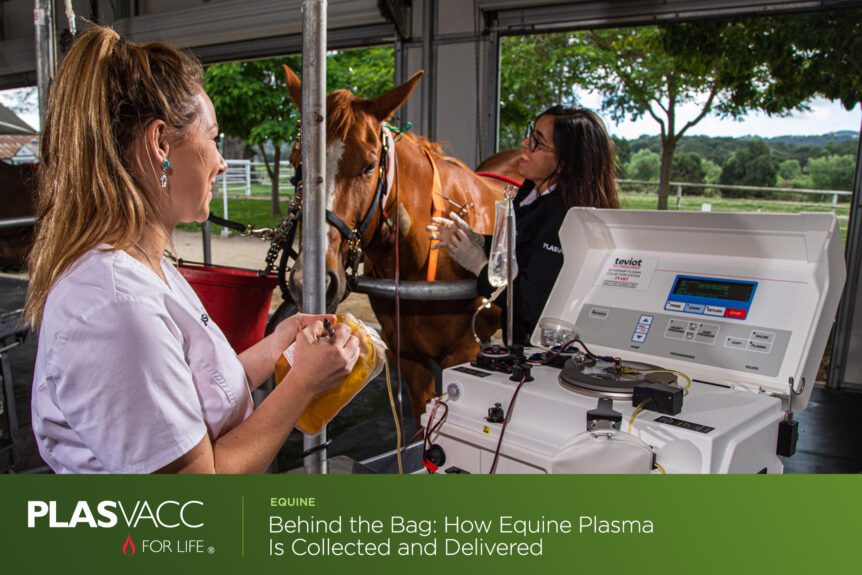Veterinarians know the value of plasma in critical cases. A single bag can mean the difference between a foal thriving or succumbing to infection. What’s not widely known is what goes on behind the scenes: the donor animals, the collection process, and the people dedicated to making sure every unit that leaves Plasvacc is safe, effective, and ethically sourced.
Horses with a New Purpose
A plasma donor horse isn’t just any horse pulled from a pasture. As the Plasvacc team explains, the starting point is good behavior: “A great plasma donor horse begins with having good obedience and ground manners… our donor horses live in large pastures with other horses year-round, so it’s extremely important that they can get along with other horses.”
Beyond health, personality matters. These horses are handled often, so they must be calm to catch, patient in a crosstie, and safe for staff, farriers, and veterinarians. Many come to the program after retiring from other work, gaining a new life and a fresh purpose. You can read more about the donor herd here.
A Day in the Pasture
You might imagine the facility as clinical, but the reality is more pastoral. Donor horses only donate plasma about once a month. The rest of the time, they graze, roam, and socialize in large, irrigated paddocks.
As one of our pheresis technicians, Elisa Garnsey puts it, “We aim to emulate natural environments for our donors to live and thrive in… there is plenty of room to run, play, and buck around the pasture if they so choose.” Daily care is overseen by a licensed veterinarian, supported by dedicated technicians who form close bonds with the animals.
Technician Makenzie Meehan recalls a favorite moment with Rhonda and “…getting to scratch her while she was lying down.” She also admits Sweep’s antics keep the team entertained, as the mare “loves to rear as high as she can!” These anecdotes remind us that while the science is serious, the horses are still very much horses—with quirks, friendships, and personalities that brighten the workday.
The Collection Process
When it comes time for donation, the procedure mirrors human plasma collection. Using advanced pheresing equipment in a closed system, whole blood is drawn, the plasma separated, and red cells returned to the donor. This method, as detailed on the Plasvacc Collection Process page, keeps donors comfortable while maximizing safety.
There are eight carefully monitored steps: donor preparation, blood sampling, analysis and testing, centrifugal separation, plasma collection, return of cells, freezing and storage, and finally, distribution. Each bag is single-source and cell-free, never blended, which means traceability is absolute and the risk of reactions is reduced.
From a technical perspective, purity is everything. Protein levels are tracked during the procedure, sterility testing is performed on every batch, and immunoglobulin concentrations are confirmed in Plasvacc’s own laboratory. Plasma is frozen immediately and stored between –17°C and –40°C until shipped. You can find more about these stringent measures on the Purity and Safety page.
Safety That Rivals Human Standards
It’s easy to forget that veterinary plasma is held to many of the same standards as human products. Equiplas, equine plasma is USDA-licensed, and the same closed-system technology used for human collection is employed here. Anticoagulant sodium citrate is the only additive. No preservatives, no pasteurisation, nothing that dilutes the natural efficacy.
For clinics, this means confidence. When a unit of plasma is delivered, it has passed every test—sterility, antibody levels, purity, and safety—long before it leaves the facility.
What Surprises New Staff?
According to Makenzie Meehan, it’s not the science that surprises new team members most, it’s the bonds. “Being able to form a bond with the horses… I enjoy getting to see all of their different personalities.”
For many staff, the reward lies not just in producing life-saving plasma, but in giving horses a new role, a safe environment, and meaningful daily care. As one technician explained, horses that might no longer be able to perform their old duties “come here to have a new purpose, while receiving quality care.”
From Paddock to Patient
By the time plasma reaches a veterinary practice, it’s already been through a long journey: from the careful selection of donor horses to the precision of collection and the scrutiny of testing, all under the watchful eyes of those who care for the herd every day.
The result? Each bag is not just a treatment, but a story of science, compassion, and teamwork. For more details, you can visit the FAQ page or speak with the Plasvacc team about product availability and protocols.
Closing Thought
Plasma is often thought of as a product, but perhaps it should be seen as a promise. Behind every bag is a herd of well-cared-for horses, a team of skilled technicians, and a system built on safety and trust. When veterinarians administer plasma, they’re drawing on that entire chain of care.

